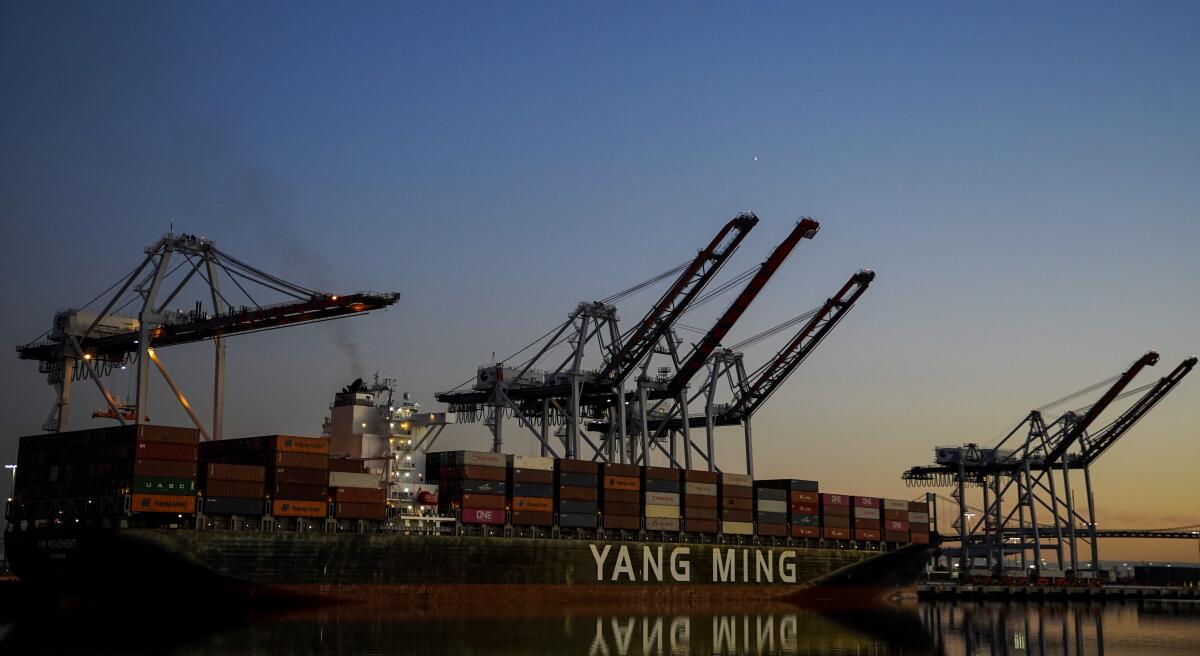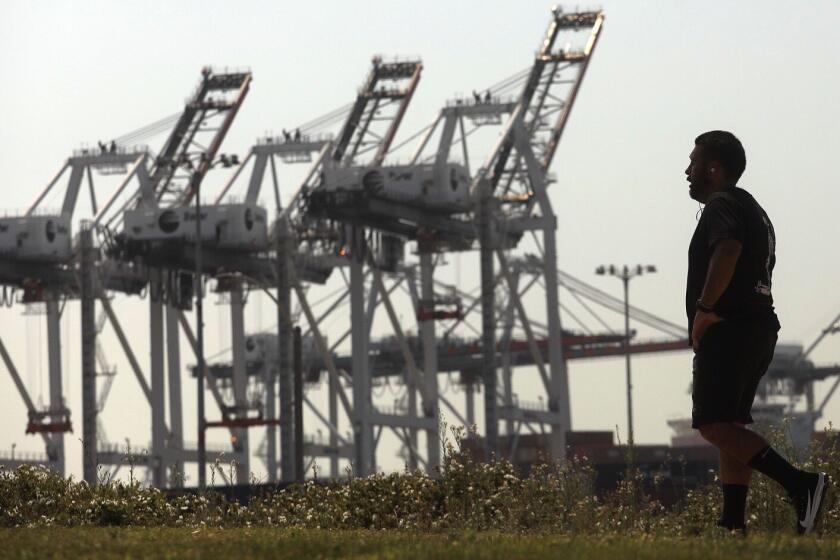Editorial: Another year, another broken promise to curb air pollution from L.A. ports

- Share via
Southern California air quality regulators are reneging on their promise to enact long-delayed rules to curb health-damaging and planet-warming pollution from the ports of L.A. and Long Beach by the end of this year.
In doing nothing once again, the South Coast Air Quality Management District has failed to do its only job, cowering in the face of opposition from organized labor and powerful business interests that have worked together on a campaign to kill the proposal meant to clean up the region’s biggest single source of smog-forming pollution.
It is clear the opposition has succeeded. The air-quality agency and its 13-member governing board has backed down, breaking the pledge of its chair, Vanessa Delgado, who in May committed to adopting a rule by the end of the year.
Instead, the district is now floating a far weaker alternative: Requiring the ports to plan for zero-emission infrastructure, a toothless approach that includes no emissions reductions and isn’t expected to be considered until later next year.
Southern California air quality officials discussed port pollution at a luxury Rancho Mirage resort 100 miles from the harbor, when they should be adopting long-delaying rules for L.A. and Long Beach ports to slash health-damaging emissions.
This is no way for regulators to respond to the serious and ongoing health threat from port pollution. A heavy concentration of soot-spewing diesel trucks, ships, trains and cargo-handling equipment worsens smog across the region and contributes to elevated cancer risk in harbor-area communities. Southern California cannot clean its air to federal health standards without drastic pollution cuts at the ports, and the failure to meet those standards is responsible for at least 1,500 early deaths a year, according to the air district, as well as thousands of excess hospital and emergency room visits for asthma, heart attacks and other health crises.
There is no question air quality officials are up against formidable adversaries, including the Pacific Merchant Shipping Assn., the International Longshore and Warehouse Union and other labor and business interests that have been working together to kill the clean-air rules on the nation’s busiest port complex. Union workers have joined freight industry lobbyists, showing up at public meetings as part of a coordinated opposition campaign to stoke fears of “devastating impacts” to California’s supply chain and economy.
There was “strong sentiment,” Air Quality Management District spokesperson Nahal Mogharabi said, “some in support and much in opposition to any effort to regulate the ports.”
Gov. Gavin Newsom and other leaders must mount a strong offense as well as robust defense against attacks on environmental protection and climate change mitigation.
While some opponents have valid concerns about new regulations (effects on jobs would be analyzed and addressed in the rulemaking process), others clearly have a profit motive to obstruct and delay.
The terminal operators, shipping companies and other industries dependent on the movement of cargo argue, spuriously, that these port pollution rules are actually just limits on economic activity. They claim there is no way to accelerate emissions reductions at the ports without reducing the movement of cargo and diverting shipments to other less environmentally friendly ports, despite reams of evidence to the contrary.
We don’t buy it. California has for decades relied on tough air quality standards to force and accelerate technological change across many industries. We have cleaned the air and grown the economy at the same time, as demonstrated by the ports’ own data showing decreasing emissions over time, even as cargo volumes rise.
L.A. Mayor Karen Bass and Long Beach Mayor Rex Richardson are also to blame. While they came out in favor of a zero-emission infrastructure plan, neither Bass nor Richardson would say whether they support an air district rule that would actually cut port pollution. Everything suggests they don’t. The city-owned ports, which Bass and Richardson control, have long opposed local air quality rules for them, even those as modest as holding the ports to their own clean-air plans and zero-emission pledges.
Gabby Maarse, a spokesperson for Bass, said the mayor “is committed to improving the lives of Angelenos living near the port, especially when it comes to prioritizing the improvement of public health.” Richardson said his commitment to reducing port emissions had not wavered.
The staggering backlog of basic maintenance is driving up Los Angeles’ liability costs, leaving even less money to repair public infrastructure.
Most concerning of all is the unending and craven abdication by the Air Quality Management District board, made up of local elected and appointed officials from Los Angeles, Orange, Riverside and San Bernardino counties, whose only job is cleaning the air to protect public health.
If the board’s members lack the courage to stand up to labor and business interests and regulate the biggest polluter in the nation’s smoggiest region, what hope is there that they will do so under the more challenging landscape ahead? Soon they will be operating under another Trump administration that’s expected to try again to take away the state’s authority to clean the air. Local leaders need to step up and do more.
Next time you look out on the horizon and see the brown haze that pollutes the L.A. air for much of the year, remember that Southern California could be experiencing clearer skies, fewer cancer cases, less asthma and longer lives. These are benefits that people in other parts of the country already enjoy, but we don’t, because those with the power to fix it are too afraid to act.
More to Read
A cure for the common opinion
Get thought-provoking perspectives with our weekly newsletter.
You may occasionally receive promotional content from the Los Angeles Times.













